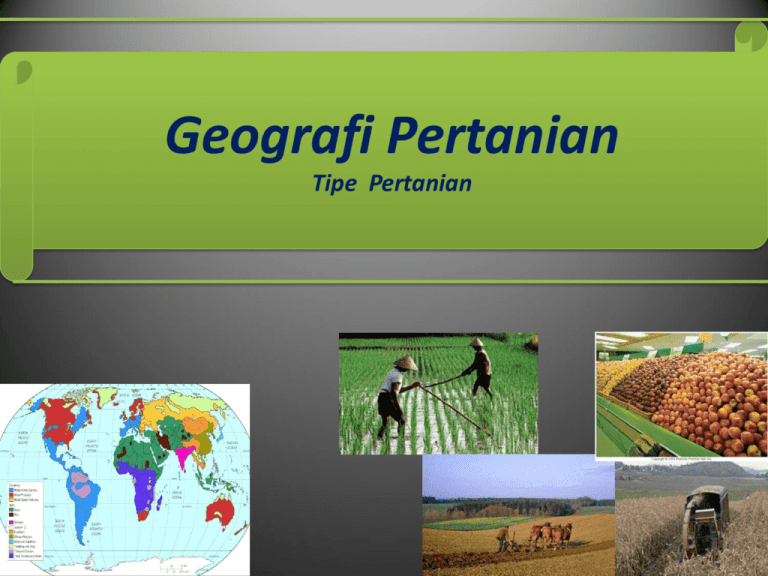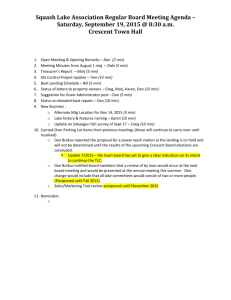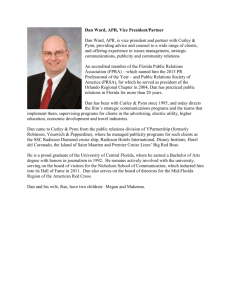Media Geo Pertanian IV
advertisement

Geografi Pertanian Tipe Pertanian Perkembangan Pertanian • Hunter-Gatherers • Neolithic Revolution – Domestication of Plants and Animals – Diffusion of Agriculture • Agricultural Industrialization • The “Green Revolution” – Hybrids, scientific application of fertilizer, pesticide, and water • Modern Agribusiness • Genetic Engineering of Crops Neolithic Revolution Primary effects: Urbanization Social stratification Occupational specialization Increased population densities Secondary effects: Endemic diseases Famine Expansionism Origins of Agriculture Which of these areas are considered cultural hearths? Contemporary Food Consumption Is there a spatial relationship to the original hearths? Contemporary Food Production Agriculture is a global economy. Developed Countries Undercut Free Markets in Agriculture • Farmers in the developed world are paid an average of 2/3 more than the free market would provide. • These subsidies to the world’s richest farmers directly damage the agricultural economies of the poorest nations. Agricultural Revolutions Technology allows much greater production (surplus) with less human labor, but often has high social and environmental costs. Metal plows, Reapers, Cotton Gin Tractors (Internal Combustion Engine) Combines Chemical Pesticides/Fertilizers Hybrid Crops Genetically-modified Crops Agribusiness: The industrialization of agriculture Modern commercial farming is very dependent on inputs of chemical fertilizer, pesticides, herbicides. Oil is required to make fertilizer and pesticides. It takes 10 calories of energy to create 1 calorie of food in modern agriculture. Small farmer can’t buy needed equipment and supplies. Fewer than 2% of U.S. population works in agriculture Classifying Agricultural Regions Subsistence Agriculture • Shifting Cultivation • Pastoral Nomadism • Intensive Subsistence Agriculture Commercial Agriculture • Mixed Crop and Livestock Farming • Dairy Farming • Grain Farming • Livestock Ranching • Mediterranean Agriculture • Truck Farming Subsistence Agriculture Regions Shifting Cultivation Vegetation “slashed” and then burned. Soil remains fertile for 2-3 years. Then people move on. where: tropical rainforests. Amazon, Central and West Africa, Southeast Asia Crops: upland rice (S.E. Asia), maize and manioc (S. America), millet and sorghum (Africa) Declining at hands of ranching and logging. Perladangan Berpindah Lahan ditanami berpindah secara berkala, sehingga lahan yang telah dipanen sebelumnya dibiarkan bera dan menjadi hutan kembali kemudian akan ditanami lagi setelah siklus waktu tertentu Dijumpai di wilayah hutan tropik basah (di Indonesia: di sebagian daerah Sulawesi, Kalimantan, Irian dan sebagian kecil Sumatra) Lahan adalah milik bersama dan dikuasai oleh kelompok sosial ( suku). Kepala suku/adat umumnya menentukan lahan yang boleh dimanfaatkan oleh setiap keluarga/anggota sukunya. Masa regenerasi perpindahan akan mempertahankan kesuburan lahan, kalau hal itu berlangsung cukup lama dan jumlah penduduk sedikit. Pekerjaan dilakukan keluarga, pembagian kerja menurut adat istiadat. Pria membuka lahan, wanita bertanggung jawab menanami, mengolah dan yang lebih maju lagi menangani pemasaran hasil pertanian. Pastoral Nomadism The breeding and herding of domesticated animals for subsistence. Bedouin Shepherd Somali Nomad and Tent where: arid and semi-arid areas of N. Africa, Middle East, Central Asia animals: Camel, Goats, Sheep, Cattle transhumance: seasonal migrations from highlands to lowlands Most nomads are being pressured into sedentary life as land is used for agriculture or mining. Penggembalaan Berpindah Merupakan tipe penggembalaan dimana ternak digiring secara periodik ke padang rumput Dua sistim utama penggembalaan berpindah : (1) Sistim tranchumance - imigrasi secara periodik kawanan hewan milik orang yang hidup menetap, (2) Sistim pastoral nomadism---penggembalaan oleh kelompok sosial (suku atau keluarga besar) dengan hewan gembalanya melewati wilayah suku berupa padang rumput yang umumnya dimiliki atas dasar tradisi dan kekuasaan Ternak--cadangan pemenuhan kebutuhan sendiri dan saat nomadik serta sebagai simbol martabat Penggembalaan berpindah nampaknya masih bisa dilacak di wilayah Indonesia bagian timur terutama untuk daerah-daerah padang rumput di Nusa Tenggara Timur Intensive Subsistence Agriculture • Wet Rice Dominant The Fields of Bali Thai Rice Farmers where: S.E. Asia, E. India, S.E. China very labor intensive production of rice, including transfer to sawah, or paddies most important source of food in Asia grown on flat, or terraced land Double cropping is used in warm winter areas of S. China and Taiwan Pertanian Keluarga Hak milik dan hak pakai ada di tangan masing-masing keluarga. Pengelolaan dan pekerjaan dilakukan oleh keluarga yang memiliki lahan pertanian, dan dengan demikian tidak terikat kepada kelompok sosial yang lebih besar Lahan adalah faktor pemersatu dalam sistim sosial pedesaan sekaligus sebagai landasan kehidupan, faktor produksi, kemakmuran dan tempat tinggal. Sesuai dengan tradisi, lahan tidak dijual, melainkan dimanfaatkan dan kemudian diwariskan kepada generasi berikutnya (keberlanjutan generasi)---- keep in mind of family farming in Japan case !!!! Jika luas cukup--memenuhi kebutuhan kel. tani-- pertanian keluarga merip sistim yang stabil dengan perbedaan sosial kecil, sehingga cocok bagi kegiatan koperasi----dapat dikelola secara komersial Pertanian Feodalistik • Feodalisme--stratifikasi sosial-kepemilikan aset: Dua tipe • • • • pertanian feodalistik yaitu (1) feodalisme persewaan dan (2) latufundia (hacienda) Feodalisme Persewaan-- kekuasaan ekonomi sbg dasar tuan tanah untuk menguasai petani kecil dan landless. Petani kecilterpaksa membayar sewa tinggi, tergantung secara pribadi pada pemilik aset besar-terjadi konsentrasi pemilikan modal Bagi tuan tanah-lahan sbg. kekayaan untuk disewakan dan juga martabat dan kekuasaan -baca buku James Scott (Moral Economy). Latufundia -pemilikan lahan yang luar biasa luasnya (exp. Amerika Latin). Bentuk hacienda (facenda)- UU kolonial yang memperbolehkan kerja paksa/ pemberian hadiah lahan bagi jasa kemiliteran Lahan merupakan sumber kehormatan, kekuasaan, dan spekulasi ekonomi. Commercial Agriculture Value-Added Very little of the value of most commercial products comes from the raw materials “adding value” is the key to high profit margins Roughly 6% of the price of cereal is the cost of the grain. Mixed Crop and Livestock Farming Mixed Crop and Livestock Farming Where: Ohio to Dakotas, centered on Iowa; much of Europe from France to Russia crops: corn (most common), soybeans In U.S. 80% of grain production is fed to pigs and cattle! Highly inefficient use of natural resources Pounds of grain to make 1 lb. beef: 10 Gallons of water to make 1 1b wheat: 25 Gallons of water to make 1 1b. beef: 2500 Pertanian Kapitalistik • Tipe pertanian kapitalistik yang paling penting di negara yang sedang berkembang adalah plantation /esatate /“perkebunan”. • Sebuah perkebunan ialah sebuah pertanian yang berskala besar yang mengutamakan tanaman tahunan misalnya pohon, semak atau perdu, seringkali sistim penanamannya satu jenis (monokultur)--- sawit, karet, cengkeh, kopi, dll • Hasilnya biasanya diolah secara industri di pabrik pengolahan perkebunan itu sendiri dan diarahkan untuk ekspor---- mendahulukan kepentingan asing dan merupakan suatu gugus yang tertutup –ada persepsi-only has small economic impact to the peasant/villagers. Pertanian Kolektif Didalam pertanian kolektif , produksi telah diserahkan kepada rakyat dan produksi direncanakan oleh negara. Pertanian kolektif umumnya bukan hanya merupakan sistim ekonomi tetapi lebih merupakan pandangan hidup secara keseluruhan, berdasarkan politik, etika Pertanian Komunistik • Sindrom politik atau etika keagamaan. Contoh—China komune/masyarakat memunyai satu bentuk kolektif yang meliputi semua sektor kehidupan dan ekonomi tidak hanya terbatas peda sektor pert. saja. • Kesatuan ini dapat mencapai luas sebuah desa mancakup produksi pertanian dan industri, jasa, pendidikan, pelayanan kesehatan, kebudayaan, administrasi dan masalah-masalah politik maupun aspek-aspek konsumsi dan kehidupan pribadi. • Tata kerja diatur ketat menyerupai militer. Kebutuhan dasar diatur atas persamaan hak dan dipenuhi oleh upah dasar dalam bentuk uang kontan dan natura berupa makanan pokok maupun pembebanan biaya pendidikan, pelayanan kesehatan dan sebagainya. • Perbedaan pendapatan --- antar komune --Penggunaan paksaan -menjamin peran serta masyarakat- tekanan politik maupun keadaan darurat Pertanian Sosialistik Ideologi sosialistik--- pemikiran pribadi atas lahan mengarah pada “pemerataan”. Pertanian sosialistik memiliki konsepsi bahwa pertanian kecil telah ketinggalan oleh kemajuan teknik dan oleh karena itu harus digabungkan dengan unit-unit ekonomi yang besar -- perencanaan produksi yang ketat oleh pemerintah Contoh: Rusia kolkhoz, pengendalian produksi dibawah pengaruh negara namun negara tidak diharuskan menanggung resiko ekonomi – membawa perbaikan pada sebagian kelompok rumah tangga yang berpenghasilan rendah -- Kelemahan: terjadi penumpukan unskilled workers, pengawasan dan birokrasi komplek dan tingkat produksi rendah Dairy Farming Where: near urban areas in N.E. United States, Southeast Canada, N.W. Europe - Over 90% of cow’s milk is produced in developed countries. Value is added as cheese, yogurt, etc. Dairy Farm, Wisconsin Von Thunen’s theories are the beginning of location economics and analysis (1826) Locational Theory : butter and cheese more common than milk with increasing distance from cities and in West. Milkshed : historically defined by spoilage threat; refrigerated trucks changed this. Prairie Cereal Farming Where: worldwide in semi-arid midlatitudes, but U.S. and Russia predominant Crops: wheat winter wheat: Kansas, Colorado, Oklahoma spring wheat: Dakotas, Montana, southern Canada Highly mechanized: combines, worth hundreds of thousands of dollars, migrate northward in U.S., following the harvest. Livestock Ranching Where: arid or semi-arid areas of western U.S., Argentina, Brazil, Uruguay, Spain and Portugal. History: initially open range, now sedentary with transportation changes. Environmental effects: 1) overgrazing has damaged much of the world’s arid grasslands (< 1% of U.S. remain!) 2) destruction of the rainforest is motivated by Brazilian desires for fashionable cattle ranches Pertanian Mediterania Where: areas surrounding the Mediterranean, California, Oregon, Chile, South Africa, Australia Climate has summer dry season. Landscape is mountainous. • Highly valuable crops: olives, grapes, nuts, fruits and vegetables; winter wheat • California: high quality land is being lost to suburbanization; initially offset by irrigation Commercial Gardening and Fruit Farming Where: U.S. Southeast, New England, near cities around the world • crops: high profit vegetables and fruits demanded by wealthy urban populations: apples, asparagus, cherries, lettuce, tomatoes, etc. • mechanization: such truck farming is highly mechanized and labor costs are further reduced by the use of cheap immigrant (and illegal) labor. • distribution: situated near urban markets. Plantation Farming • large scale mono-cropping of profitable products not able to be grown in Europe or U.S. • where: tropical lowland Periphery • crops: cotton, sugar cane, coffee, rubber, cocoa, bananas, tea, coconuts, palm oil. What are potential problems with this type of agriculture? Environmental? Social? Making Sense of the Map of US Agricultural Regions The Green Revolution in Agriculture The term green revolution refers to the development and adoption of high yielding cereal grains in the less developed world during the 1960s, 1970s, and 1980s. Very large short term gains in grain output have allowed food supplies to grow faster than populations, until very recently. Green Revolution History Acreage and Yield Trends Technical Problems Ethical Issues 1943 Rockefeller Foundation begins work on short stature hybrid corn in Mexico 1960s Hybrid strains of rice, wheat, and corn show great success in S.E. Asia, and Latin America. 1970 Head of Mexican corn program, Borlaug, wins Nobel Peace Prize 1990s Growth in food supply continues, but slows to below the rate of population growth, as the results of unsustainable farming practices take effect. Acreage and Yield Trends Gains were made by: • Dwarf varieties: plants are bred to allocate more of their photosynthetic output to grain and less to vegetative parts. • Planting in closer rows, allowed by herbicides, increases yields. • Bred to be less sensitive to day length, thus double-cropping is more plausible. • Very sensitive to inputs of fertilizer and water. Acreage and Yield Trends Acreage and Yield Trends Acreage and Yield Trends Acreage and Yield Trends Notice the trend in recent years is level or down. Technical and Resource Limitation Problems Technical and Resource Limitation Problems • Heavy Use of Fresh Water • High Dependence on Technology and Machinery Provided/Sold by Core Countries • Heavy Use of Pesticides and Fertilizer (and associated pollution and waste) • Reduced Genetic Diversity / Increased Blight Vulnerability Technical and Resource Limitation Problems Ethical Issues • Starvation of many prevented, but extra food may lead to higher birth rates. • Life expectancy in less developed countries increased by 10 years in less than two decades (43 in 1950’s to 53 in 1970’s). • Dependency on core countries increased; rich-poor gap increased. • Wealthy farmers and multinational companies do well, small farmers become wage laborers or unemployed – dependent. • More at risk? More people malnourished/starving today than in 1950 (but lower as a percentage). • U.S. spends $10,000,000,000 year on farm subsidies, damaging farmers and markets in LDCs. Agricultural ‘Success’? “Our incredible successes as a species are largely derived from this choice, but the biggest threats to our existence stem from the same decision.” Jared Diamond, 1999 Emergence of new human diseases from animal diseases (i.e. smallpox, measles) • Dense urban populations allow spread/persistence of disease Lower standard of living for many people. • Archaeological evidence of serious mal-nourishment among early farmers. • Many modern impoverished and malnourished farmers. • Famine virtually non-existent in hunter-gatherer societies. Increased susceptibility to plant blights and increased dependence on complex economic systems. Environmental degradation • topsoil loss (75% in U.S.), desertification, eutrophication, PCBs in fish, DDT and other pesticides Biotechnology in Agriculture • Cloning • Recombinant DNA BT Corn Debate (transgenic maize) Biotechnology in Agriculture • Potential Benefits of Genetic Engineering of Crops – Increased Yields – Increased Nutritional Value in Some Staple Crops (e.g., Vitamin A added to Rice) • Strong Political Resistance in Europe and Among Environmentalists Worldwide • Concerns about Long Term Safety and Risks Future Challenges • World Population Expected to Increase to 10-12 Billion Before Stabilizing • Food Production Already Exerting Extreme Environmental Pressures – 25% of All Greenhouse Gas Release in U.S. is from Agriculture. That’s more than all transport. – Much Soil is Already Badly Damaged • Developed Countries Still Undermining 3rd World Agriculture with Subsidies and Taxes







